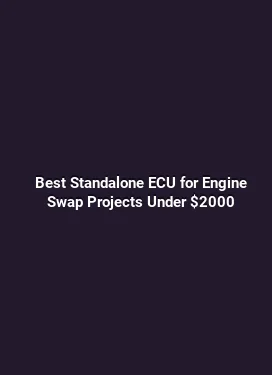MoTeC M150 vs Haltech Elite 2500 ECU: A Thorough Engine Management Comparison for Race Cars
Choosing the right engine management system is pivotal for race cars where response, reliability, and repeatability translate to lap times. The MoTeC M150 and the Haltech Elite 2500 represent two of the most capable, feature-rich ECUs in modern motorsport. Rather than relying on marketing gloss, this comparison dives into real-world performance characteristics, installation considerations, and tuning workflows that teams encounter on the track. Readers will find practical guidance on sensor integration, mapping strategies, data logging capabilities, and reliability factors that influence decision-making for different racing disciplines and engine configurations.
Overview of the ECU Landscape for Race Cars

Across modern race programs, the core challenge is delivering precise fuel delivery, ignition timing, boost control, and traction management without introducing instability. Both the M150 and the Elite 2500 are designed to handle high channel counts, complex boost strategies, and advanced drive-by-wire control while maintaining deterministic ECU operation under demanding conditions. In practice, the choice between them often hinges on the team’s existing infrastructure, sensor ecosystem, and the preferred workflow for calibration and data analysis.
Engine management in competition environments benefits from a modular philosophy: a powerful ECU in combination with robust wiring, reliable sensing, and a coherent data pipeline accelerates iteration cycles. While both platforms excel at these core requirements, the nuances of their software ecosystems, hardware I/O, and real-time processing capabilities can tilt the balance for a given project. The following sections unpack these nuances with concrete, field-tested observations.
Performance, Tuning Capabilities, and Data Acquisition
Both platforms deliver high-resolution fuel and timing maps, but the practical implications of their tuning philosophies are worth unpacking. The M150 emphasizes a highly granular, supervised mapping approach with dedicated support for rapid prototyping of calibration strategies. This translates into sophisticated fuel table structures, multi-curve ignition strategies, and clear pathways for managing lean-off and transient fueling during throttle transitions. In a race setup, this translates to more consistent air-fuel ratios across RPM and load ranges, which is critical for engine reliability and lap-time consistency.
The Haltech Elite 2500, on the other hand, is renowned for its streamlined calibration workflow and a robust, extensible sensor suite. Its architecture supports complex closed-loop control strategies and modular sensor inputs that can be reconfigured for different engines or even swapped between vehicles with relative ease. For teams that run multiple chassis or engines with shared hardware, the Elite 2500’s software toolchain often reduces reprogramming time and minimizes calibration drift between configurations. Data logging on both platforms is substantial, but the logging depth, trigger logic, and post-processing flexibility can influence which system best fits the team’s analytics workflow.
MoTeC M150 Core Features and Tuning Philosophy

The M150 stands out for its capacity to manage many inputs and outputs with high precision. It supports advanced timing strategies, including sequential ignition for multi-staged turbo setups and sophisticated boost control algorithms. A notable advantage is the ability to craft detailed fuel and ignition maps that respond to complex sensor feedback, enabling nuanced control during corner entry, apex, and exit phases. The hardware platform is designed to deliver consistent performance even under harsh electrical environments, which is a meaningful asset for race cars operating in damp or high-vibration conditions.
From a workflow perspective, the M150 often benefits teams that prioritize deep, customized calibration. Its software environment supports a multi-parameter view that engineers can tailor to individual race scenarios, such as endurance setups requiring stable fuel trims across long stints or sprint formats demanding rapid map switching. Practically, this translates into more predictable engine response when you push into the high-load regions of a track curve or push into a peak torque window under acceleration out of corners.
Haltech Elite 2500: Architecture and Control Philosophy
The Elite 2500 emphasizes a balance between performance and ease of use, with a strong focus on a cohesive calibration experience and fast iteration cycles. Its architecture accommodates a broad range of sensors, actuators, and auxiliary systems, making it a flexible choice for teams that experiment with different engine configurations across seasons. A practical benefit is the reliability of the feature set when addressing common race-day challenges such as sensor fault tolerance, rapid re-tuning during practice sessions, and dependable engine protection logic.
For teams prioritizing a streamlined data-driven approach, the Elite 2500’s tooling often reduces the friction between data collection and interpretation. This translates into faster confirmation of calibration decisions, more confident tuning during practice sessions, and quicker translation of track observations into actionable map adjustments. The platform’s support for closed-loop control, when used judiciously, can deliver meaningful gains in driveability without sacrificing top-end performance, which is particularly valuable in endurance events where consistency matters as much as peak power.
Fuel and Ignition Mapping: Practical Differences
Fuel and ignition maps are the crux of any engine management system. The way each platform interprets sensor data, applies corrections, and interpolates between map points determines not only peak power, but also stability and repeatability across varied track conditions. Both systems are capable of delivering tight control, but the approach to map construction, sensor enrichment, and fault handling can influence which is most effective for a given engine and racing format.
In practice, teams using the M150 may gravitate toward deeper, more granular map grids that enable fine-tuning of knock sensitivity, transient fueling, and boost response. This precision can pay dividends for engines with aggressive cam profiles, forced induction, or highly variable intake conditions where small map adjustments yield noticeable performance and reliability improvements. Conversely, the Elite 2500’s mapping approach often emphasizes a balanced, fast-to-tune workflow with robust default baselines. For many race cars, this translates to a shorter development curve, quicker initial performance gains, and a dependable baseline from which to iterate during practice weeks.
Driveability, Mapping Strategy, and Robustness
Driveability is not only about smoothness; it also encompasses how consistently the engine responds to driver input under changing load and temperature. The M150’s mapping strategy can be leveraged to produce highly predictable throttle response and fuel trim stability, especially in high-boost or high-mixture environments. Practitioners often report that the software’s capability to manage multi-dimensional maps helps reduce unwanted ignition misfires and fuel instability during aggressive corner exits or rapid throttle applications.
On the Haltech side, driveability is helped by a coherent, integrated approach to sensor fusion, redundant inputs, and a robust protective layer that guards against misconfigurations. The Elite 2500’s system often yields strong performance with a shorter learning curve, which is advantageous when time on track is limited or when engineers need rapid validation of calibration hypotheses. A key practical takeaway is to plan calibration runs that test edge cases—such as rapid throttle changes at high RPMs and high load—to ensure that the chosen platform maintains stable fueling and ignition without resorting to conservative detuning that would compromise lap times.
Data Logging, Diagnostics, and Track-Wide Consistency
Data logging capabilities are a cornerstone of modern race engineering. Both platforms provide rich channels, high sampling rates, and flexible logging configurations. The ability to capture high-frequency sensor data (MAP, MAF, IAT, EGT, KOER, AFR, oil pressure, fuel pressure) and correlate it with audio and video cues can dramatically shorten iteration cycles and improve post-event analysis. In track environments, data integrity and ease of retrieval are as crucial as raw channel count; engineers need stable logging, reliable timestamping, and straightforward export workflows to share insights with the team.
Both ECUs offer powerful diagnostic tools, but the practical experience of teams often centers on how quickly data can be wired to a pit-lane laptop or a performance analytics platform, and how intuitive the extraction and visualization processes are. The M150’s high level of configurability can be a double-edged sword: it enables deep diagnostics and customizable dashboards, but it may require more time to set up before a session. The Elite 2500 tends to provide a smoother out-of-the-box experience with cohesive dashboards and pre-built templates, which accelerates early data capture and trend identification, especially for teams that rely on rapid decision-making on race weekends.
Wiring, Sensor Integration, and System Reliability
Reliable wiring and sensor integration are fundamental to consistent performance. The M150's extensive I/O capacity is well-suited for complex engines with multiple fuel pumps, nitrous systems, or variable valve timing strategies. Engineers can tailor power management strategies, sensor power rails, and shielded signal paths to minimize interference and ensure clean data. In endurance contexts, this translates to a decreased likelihood of spurious sensor readings that could trigger protective modes or misfire protections during a stint.
Haltech’s Elite 2500 architecture emphasizes a robust, well-documented integration path with a focus on reliability under race conditions. The system’s sensor fusion capabilities help maintain stable operation even when individual sensors pick up noisy signals or experience momentary drift. This reliability, combined with a straightforward data export and analysis workflow, makes it appealing for teams aiming to maximize time on track and minimize software setup overhead between sessions.
Practical Setup Tips for Racing Teams
When selecting between the MoTeC M150 and the Haltech Elite 2500, practical considerations often weigh as much as raw capability. A systematic approach to setup begins with inventorying the engine peripherals, sensors, actuators, and data acquisition needs. Create a mapping of required inputs (throttle position, manifold pressure, air temperature, fuel pressure, boost control, wastegate signals) and outputs (injectors, ignition coils, boost solenoids, variable cam actuators). Both platforms can accommodate these requirements, but aligning the hardware ecosystem with the chosen ECU can streamline calibration, fault diagnosis, and maintenance during a race season.
Another pragmatic aspect is the track-side support ecosystem. Consider the availability of technicians, the extent of online documentation, and the presence of local tuning expertise for each platform. In addition, evaluate the ease of upgrading firmware, expanding channel counts, or integrating additional data sources such as telematics or external wheel-speed sensors. A future-proof setup often leads to fewer mid-season disruptions and a smoother progression from practice to qualifying to race day.
Calibration Cadence and Team Roles
To maximize efficiency, assign clear responsibilities: one engineer focuses on fuel and ignition mapping, another handles sensor integrity and data integrity, and a third oversees the integration of telemetry and data analysis. Establish a cadence for calibration sessions—starting with a reliable baseline map, validating with data from practice runs, and iterating through targeted adjustments. Both platforms reward disciplined, repeatable calibration workflows that build a robust performance envelope without introducing recipe-driven tuning that may compromise reliability.
Finally, document every change with context: vehicle configuration, weather conditions, and track layout. A well-documented calibration history makes it easier to reproduce success on future events and to compare performance across different engines or chassis configurations. This practice reduces the learning curve for new crew members and helps sustain performance gains across a season.
Real-World Takeaways: Which ECU Fits Your Race Program?
For teams prioritizing maximum customization potential, deeper map control, and a workflow that rewards experimental calibration, the MoTeC M150 offers a potent toolkit. Its granular control and extended parameter space can unlock performance gains on engines with bespoke configurations, turbocharged setups, or advanced ignition strategies where precise map shaping makes a measurable difference on track time. The trade-off is a steeper learning curve and a longer path to fully optimized maps, especially for newcomers or teams with limited time on track for iterative testing.
In contrast, the Haltech Elite 2500 provides a compelling blend of capability and accessibility. If a team values a faster ramp to a strong baseline, reliable data analytics, and a straightforward path to repeatable performance across different cars, the Elite 2500 is an advantageous choice. Its architecture and tooling often reduce calibration time, which translates to more practice and testing hours, a valuable commodity during tight race weeks or when testing limited to specific venues.
Conclusion: A Closer Look at Long-Term Value
Both the MoTeC M150 and the Haltech Elite 2500 are robust, race-proven platforms capable of delivering the precision, reliability, and data-driven insight required for modern motorsport. The best choice depends on the team’s engineering philosophy, the engine configuration, and the pace at which calibration work can be completed within the season’s schedule. For some programs, the depth and customization potential of the M150 justify the additional setup time. For others, the Elite 2500’s balanced approach and streamlined workflow deliver the fastest path to consistent lap times and dependable performance under diverse race conditions.
Across either option, success comes from a disciplined calibration process, well-planned sensor integration, and a data-informed approach to tuning decisions. Harnessing high-fidelity data, maintaining hardware reliability, and fostering efficient collaboration among engineers, technicians, and drivers are the practical catalysts that convert ECU capability into race-winning performance.






